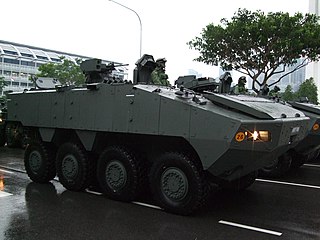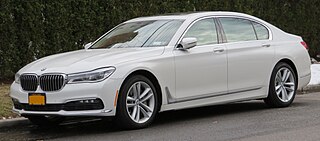
The Patria AMV is an 8×8 multi-role military vehicle produced by the Finnish defence industry company Patria.

A diesel–electric transmission, or diesel–electric powertrain, is a transmission system powered by diesel engines for vehicles in road, rail, and marine transport. Diesel–electric transmission is similar to petrol–electric transmission, which is powered by petrol engines.

The Volvo C30 is a three-door, front-engine, front-wheel-drive premium compact hatchback manufactured and marketed by Volvo Cars from 2006 to 2013, in a single generation. Powered by inline-four and straight-five engines, the C30 is a variant of the Volvo S40/V50/C70 range, sharing the same Ford C1/Volvo P1 platform. Volvo marketed the C30 as a premium hatchback / sports coupe.

In a motor vehicle, the powertrain comprises the main components that generate power and deliver that power to the road surface, water, or air. This includes the engine, transmission, drive shafts, differentials, and the final drive. Hybrid powertrains also include one or more electric traction motors that operate to drive the vehicle wheels. All-electric vehicles eliminate the engine altogether, relying solely on electric motors for propulsion. Occasionally the term powerplant is casually used to refer to the engine or, less often, the entire powertrain.

The Terrex Infantry Carrier Vehicle (ICV) is an armoured fighting vehicle (AFV) developed by ST Engineering of Singapore and Timoney Technology of Ireland, and produced by ST Engineering Land Systems for the Singapore Army as well as by Turkish auto-maker Otokar as the Yavuz (AV-82) for the Turkish military.
Hybrid Synergy Drive (HSD), also known as Toyota Hybrid System II, is the brand name of Toyota Motor Corporation for the hybrid car drive train technology used in vehicles with the Toyota and Lexus marques. First introduced on the Prius, the technology is an option on several other Toyota and Lexus vehicles and has been adapted for the electric drive system of the hydrogen-powered Mirai, and for a plug-in hybrid version of the Prius. Previously, Toyota also licensed its HSD technology to Nissan for use in its Nissan Altima Hybrid. Its parts supplier Aisin offers similar hybrid transmissions to other car companies.

The Mercedes-Benz Atego is a range of general-purpose rigid trucks introduced by Daimler Truck in 1998. A new model was introduced in 2004, followed by a facelift in 2010 and another new model in 2013. The latest version is available in gross vehicle weights of 6.5 to 16 tonnes (t) and is powered by a straight 4- or 6-cylinder engine.

The Pandur II is an improved modular all-wheel-drive version of the Pandur 6×6 APC wheeled armoured vehicle. It was developed as a private venture by the Austrian company Steyr-Daimler-Puch Spezialfahrzeuge. Steyr-Daimler-Puch Spezialfahrzeuge is part of General Dynamics European Land Systems (GDELS), which is also the parent company of MOWAG of Switzerland and Santa Bárbara Sistemas of Spain.
Hybrid vehicle drivetrains transmit power to the driving wheels for hybrid vehicles. A hybrid vehicle has multiple forms of motive power, and can come in many configurations. For example, a hybrid may receive its energy by burning gasoline, but switch between an electric motor and a combustion engine.
The following outline is provided as an overview of and topical guide to automobiles:

The BMW X6 is a mid-size luxury crossover SUV by German automaker BMW. The BMW X6 is the originator of the sports activity coupé (SAC), referencing its sloping rear roof design. It combines the attributes of an SUV with the stance of a coupé. It is built in BMW's North American plant in Greer, South Carolina alongside the BMW X5, whose platform it shares. Prior to the release of the X7, the X6 was considered a flagship SUV for BMW.

Eight-wheel drive, often notated as 8WD or 8×8, is a drivetrain configuration that allows all eight wheels of an eight-wheeled vehicle to be drive wheels simultaneously. Unlike four-wheel drive drivetrains, the configuration is largely confined to heavy-duty off-road and military vehicles, such as armored vehicles, tractor units or all-terrain vehicles such as the Argo Avenger.

The Pars is an amphibious armoured combat vehicle family with 4×4, 6×6 and 8×8 versions, produced by FNSS Defence Systems of Turkey.

Timoney Technology Limited of Ireland is an Irish company which designs, develops and manufactures powertrains and independent suspension systems for heavy duty trucks, motor coaches and military vehicles. Timoney designs and develops a variety of standard armoured and soft skin mobility systems for military, commercial and specialist applications, principally utilising an independent suspension technology.

The Type 96 wheeled armored personnel carrier is an armoured vehicle that entered service with Japan in 1996, manufactured by Komatsu. This vehicle complements the existing fleet of tracked Type 73 armored personnel carriers already in service with plans to eventually replace it.
Protean Electric is an automotive technology company specializing in in-wheel motor technology. The company has developed an in-wheel, electric-drive system for hybrid, plug-in hybrid, and battery electric vehicles. Their technology creates a permanent magnet e-machine with relatively high torque and power density with the power electronics and controls packaged within the motor itself. Their in-wheel motor product is intended to be produced in low volume by Protean Electric and licensed in high volume to global automotive and Tier 1 automotive supply companies. Protean Electric is a privately held company with approximately 114 employees. Protean Electric has operations in the United States, United Kingdom, and China.

The BMW X5 (F15) is the third generation of the X5 series of mid-size luxury crossover SUVs manufactured and marketed worldwide by BMW since 2013. The car was unveiled at the 2013 Frankfurt International Motor Show. Early X5 models include xDrive50i, xDrive30d, M50d. BMW xDrive40d, xDrive35i, xDrive25d, sDrive25d were to be added in December 2013.

A drivetrain or transmission system, is the group of components that deliver mechanical power from the prime mover to the driven components. In automotive engineering, the drivetrain is the components of a motor vehicle that deliver power to the drive wheels. This excludes the engine or motor that generates the power. In marine applications, the drive shaft will drive a propeller, thruster, or waterjet rather than a drive axle, while the actual engine might be similar to an automotive engine. Other machinery, equipment and vehicles may also use a drivetrain to deliver power from the engine(s) to the driven components.

The sixth generation of the BMW 7 Series consists of the BMW G11 and BMW G12 luxury saloons. The G11/G12 generation was produced by BMW from 2015 to 2022, and is often collectively referred to as the G11.

The Lazar 3 is the latest version of the Lazar armored vehicle family of armed personnel carriers, designed for various applications and missions. It is designed and produced by Yugoimport SDPR.
















